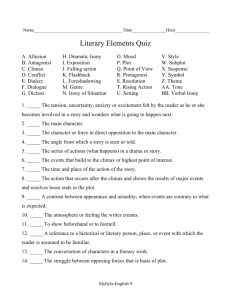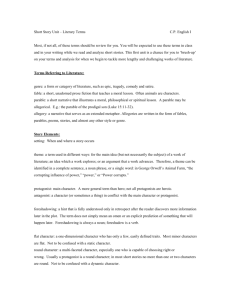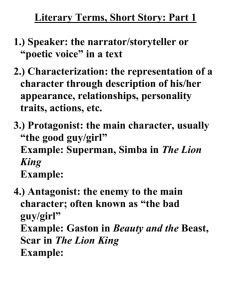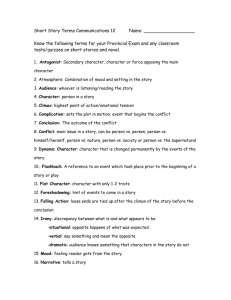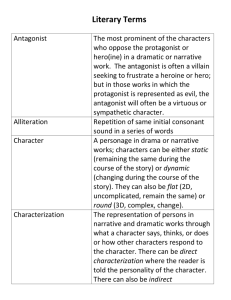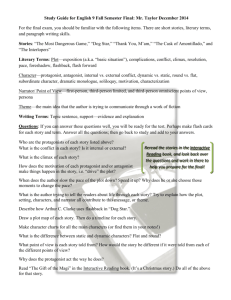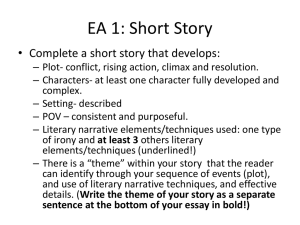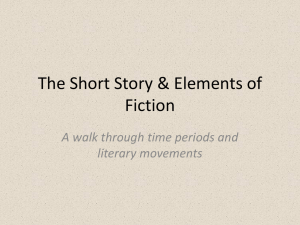Literary Terms
advertisement
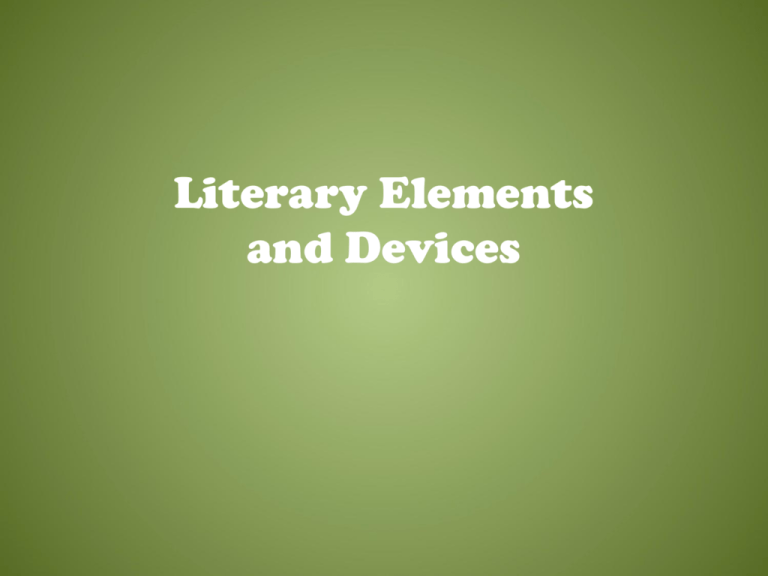
Literary Elements and Devices Plot The action or sequence of events in a story. It is usually a series of related events that build up on one another as the story develops. Plot Line Climax (Crisis, turning point, point of no return) Falling Action Exposition Resolution Exposition – The background or situation surrounding the story. This is usually where we meet characters and see the setting. Inciting Incident--the action or situation that triggers the conflict. Rising action - the series of struggles that builds a story toward a climax. Climax – the most intense (turning) point in a story. Falling action – part of the story that works out decisions reached during the climax. Resolution – is part of the story in which the problem is solved. Also called denouement. Non-linear Plot • A plot become non-linear through the use of literary techniques (e.g. Flashback, foreshadowing, parallel plot, sub-plot). It may be hard to follow and somewhat disorganized. Sub-plot A plot within a plot that relates to the main plot. Parallel structures Two or more major plots that occur within a story and usually intersect Foreshadowing The use of clues to hint at events that will occur later in the plot. Flashback An interjected scene that takes the narrative back in time from the current point the story has reached. Setting • Both the time and place of a literary work. The setting can be very specific (i.e. in a character’s bedroom at 9 pm), or more general (i.e. in the United States during the 1920s). Sometimes the reader even has to infer the setting by the details given. Conflict The problem or struggle in a story that triggers the action. There are 5 basic types of conflict. External Conflict Any struggle or problem that involves the character and any other person, thing or unknown force. – – – – Man v. Man Man v. Nature Man v. Society Man v. God (Fate) Internal Conflict Any struggle or problem that is going on within the character. Man v. Self Types of Conflict Man v. Man Man v. Self Man v. Society Man v. Fate (God) Man v. Nature Characterization Is the method an author uses to reveal characters and their personalities. There are two types of characterization Direct Characterization – In which a writer tells us directly what a character is like or what their motives are. Indirect Characterization – In which a writer shows us a character but allows us to interpret for ourselves the kind of person we are meeting. • Speech • Appearance • Private thoughts • Actions and • How others in the story feel about them. Antagonist and Protagonist Protagonist - Main character Antagonist - The person or thing working against the protagonist Static vs. Dynamic Characters • Static characters change little over the course of the narrative. Things happen TO these characters, but little happens IN them. • Dynamic characters change in response to the experience(s) through which he or she passes. Motivation • A reason or reasons that explain a character’s thoughts, feelings, actions, or behaviors. It is why the character does what he or she does. Point of View • The perspective from which a narrative is told. There are 4 main types. 1. 1st person is when the narrator is actually one of the characters in the story and uses 1st person pronouns. We know only what this character knows and observe only what he/she observes. P.O.V. cont’d 2. 3rd person limited is when the narrator is not a part of the story, but zooms in on the thoughts and feelings of only one character. We observe the action through eyes and feelings of this one character. 3. Omniscient (all knowing) is when the narrator is not a part of the story, but knows everything there is to know about the characters and their problems. Almost like a god is telling the story. P.O.V. cont’d 4. Objective Point of View With the objective point of view, Theme The statement about life, people, or human nature that the author is trying to get across in a story. – In most cases the theme will be implied rather than directly told. – What is a theme from Green Eggs and Ham? Suspense The uncertainty or anxiety we feel about what is going to happen next in a story. Dialogue A conversation between characters that may reveal their traits and advance the action of a narrative. Quotation marks indicates a speaker’s exact words. Diction, Denotation, Connotation • Diction is word choice. An author chooses words to create a specific effect. Diction helps create mood and tone. • Denotation is the specific dictionary definition of a word. It is “literal.” • Connotation is the feelings or attitudes a word brings about in people. These reactions can be positive, negative, or neutral. Mood Mood is the emotions that the reader feels while reading. Some literature makes you feel sad, others joyful, or angry, etc. Tone Tone is the attitude that an author takes toward the audience, the subject, or the character. Tone is conveyed through the diction and syntax (author's words and details). Satire A literary work that ridicules the foolishness and faults of individuals, an institution, society, or even humanity in general. Irony The general term for literary techniques that portray differences between appearance and reality, or expectation and result. There are three kinds of irony: Dramatic irony, in which the reader or the audience know more than the characters in the story. Verbal irony, in which the writer says one thing and means another: “The best substitute for experience is being thirteen” Situational irony, in which there is a great difference between what is expected to happen and what actually happens. The End…for now…


